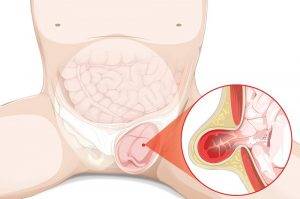According to a study on the Worldwide Magnitude of Inguinal Hernia published in Nov 2022, Asia ranked highest on the prevalence of Inguinal Hernia at 12.72% compared to America with 4.73%.
Inguinal hernia, or groin hernia, refers to a condition when part of your intestine protrudes from a weak spot in the abdominal muscle around your groin region. Inguinal hernias can occur at either of two passages, through the lower abdominal wall, one on each side of the groin. These passages are called inguinal canals. The bulging can induce pain around the groin, especially during coughing or heavy lifting. Surgical repair is generally required to fix the hernia.

Prevalence
The prevalence of inguinal hernia worldwide is approximately 1700 per 100,000 individuals for all ages and 4000 per 100,000 for those aged over 45 years. It can occur both in children and adults. Inguinal hernia accounts for 75% of all hernia conditions, with males being more susceptible than females. In the US, an estimated 5-10% of the population has an inguinal hernia, with 1 million repair surgeries performed each year.
No epidemiology data is available in Asia, but there are no differences in prevalence are identified between racial groups.
Symptoms of Inguinal Hernia
Though most inguinal hernias present as a lump around the groin, sometimes it comes and goes, and could be hard to feel, especially for those who are obese. Here are a few common signs to look out for:
- A bulge in your groin becomes bigger when coughing and standing up
- A bulge that can be pushed into your abdomen
- Pain in your groin when bending over, coughing or straining
- A heavy sensation in your groin
In severe cases when the blood supply to the protruded intestine has been occluded, symptoms could be much worse. These include:
- Sudden, severe groin pain
- The skin overlying the hernia becomes warm and red
- The bulging is not reducible
- Nausea and vomiting
- Fever
- Constipation
- Low blood pressure
Severe cases of inguinal hernia are surgical emergencies and require immediate medical attention. Delay in treatment could lead to sepsis (a life-threatening reaction to an infection) and even death.
Aetiology
Inguinal hernia can be broadly divided into two categories: indirect and direct inguinal hernia.
Indirect inguinal hernia usually occurs in young children due to a congenital defect. It may not become apparent until adulthood despite being present at birth. On the other hand, a direct inguinal hernia is an acquired condition in which the outer layer of your abdominal connective tissue becomes weakened over time. In both cases, the intestine protrudes over the weakened or defective region and causes bulging.
Treatments for Inguinal Hernia
Surgery is the only definitive treatment for inguinal hernia. The way in which surgery is conducted is the same for direct or indirect inguinal hernias. You can consider either keyhole surgery or open surgery. Your doctor would usually put a synthetic mesh between the connective tissue and muscle layers of your posterior abdominal wall to reinforce the posterior aspect of your inguinal canal. The operation is done under general anaesthesia and should last no longer than an hour. You can usually go home on the same day after the surgery.
However, it is also important to mention that surgery does not prevent you from having another inguinal hernia at another site or even at the same site. If you have minimal symptoms or are deemed unfit for surgery, your doctor might advise you to use a truss, and avoid lifting heavy weights. A hernia truss or belt is a supportive undergarment designed to keep the protruding tissue in place and relieve discomfort.
Complications
Before the surgery, some uncomplicated hernias might become complicated, resulting in urgent symptoms that require immediate surgical intervention. Bowel obstruction, gastrointestinal perforation and sepsis are not unheard of.
After the surgery, some patients might develop surgical site infection, urinary retention, and sometimes sexual dysfunction. Fortunately, most of these complications can be avoided if the surgery is done carefully without damaging the surrounding nerves and organs.
Conclusion
As one of the most frequently seen surgical conditions, inguinal hernia thankfully does not have many complications and people usually recover fully from the condition. Other common hernias include femoral hernia, commonly seen in females, umbilical hernia in the umbilicus, incisional hernia from previous surgery, and Spigelian hernia between groups of abdominal muscles. If you have any of the above-mentioned symptoms and are unsure of what is wrong, do consult your doctor. For any medical condition, it is always better late than never!

